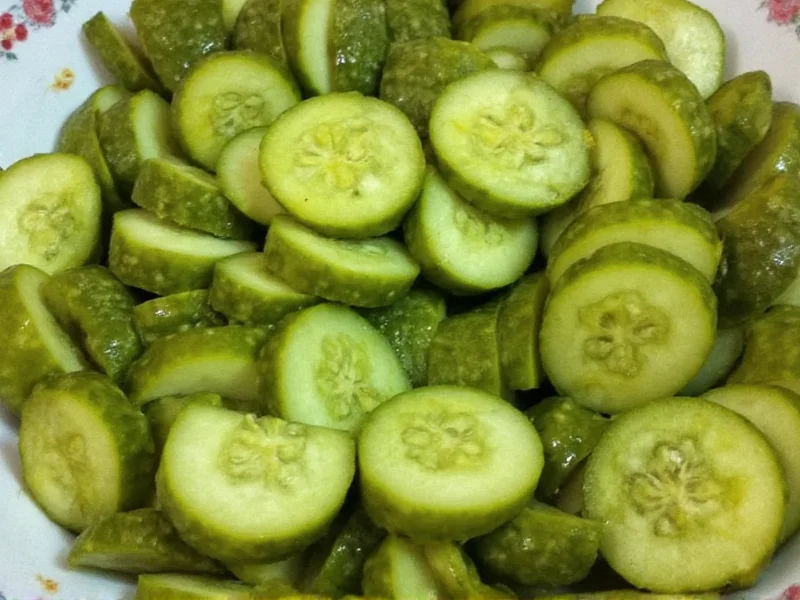Understanding the relationship between pickles and cucumbers clears up one of the most common food misconceptions. While they originate from the same plant (Cucumis sativus), their differences become significant after the pickling process begins. This distinction matters for cooking, nutrition, and even gardening purposes.
What Exactly Are Cucumbers?
Cucumbers are members of the gourd family and grow as fresh produce on vines. They consist of approximately 95% water and have a crisp texture with a mild, slightly sweet flavor. There are several varieties:
- Slicing cucumbers - Larger, smooth-skinned varieties typically eaten fresh in salads
- Pickling cucumbers - Smaller, bumpier varieties specifically bred for the pickling process
- English or seedless cucumbers - Longer varieties with thinner skins, often sold shrink-wrapped
The Pickling Process: How Cucumbers Become Pickles
Pickles are cucumbers that have been preserved through fermentation or vinegar immersion. This transformation involves several key steps:
- Selection - Pickling cucumbers are harvested at optimal size (usually 2-4 inches)
- Cleaning - Thorough washing to remove dirt and bacteria
- Brining - Submersion in a solution that may include:
- Vinegar-based brine (quick process, takes days)
- Saltwater brine (fermentation process, takes weeks)
- Flavoring - Addition of spices like dill, garlic, mustard seeds, or peppercorns
- Sealing - Proper canning to preserve the product
Key Differences Between Cucumbers and Pickles
The pickling process fundamentally changes the cucumber's properties. Understanding the difference between pickles and cucumbers helps in selecting the right ingredient for recipes and understanding nutritional content.
| Characteristic | Cucumbers | Pickles |
|---|---|---|
| Water Content | 95% water | Approximately 93% water |
| Calories (per 100g) | 15 calories | 11-18 calories (varies by recipe) |
| Sodium Content | Negligible (8mg) | Significantly higher (500-1200mg) |
| Vitamin K | High (16.4mcg) | Reduced during processing |
| Texture | Crisp, juicy | Firmer, sometimes crunchier |
| Shelf Life | 1-2 weeks refrigerated | 1-2 years unopened, 2 months refrigerated after opening |
Why People Confuse Pickles and Cucumbers
Several factors contribute to the common question are pickles just pickled cucumbers. First, in some regions, certain cucumber varieties are called "pickles" even before processing. Second, the term "pickle" technically refers to any vegetable preserved by pickling, though in North America it's become synonymous with pickled cucumbers.
Another source of confusion is that some cucumbers labeled as "pickling cucumbers" are specifically bred for the pickling process but are still fresh produce until preserved. These varieties typically have thinner skins, fewer seeds, and a crisper texture that holds up better during how pickles are made from cucumbers.
Nutritional Implications of the Pickling Process
While both cucumbers and pickles offer hydration and some nutrients, the pickling process creates significant nutritional differences. The most notable change is the dramatic increase in sodium content, which affects those monitoring salt intake. However, fermented pickles (not vinegar-pickled) contain beneficial probiotics created during the lactic acid fermentation process.
When considering nutritional differences between cucumbers and pickles, remember that vinegar-based pickles maintain most vitamins but add sodium, while fermented pickles develop beneficial bacteria but may lose some water-soluble vitamins in the process.
Can You Make Pickles From Any Cucumber?
Technically yes, but not all cucumbers produce ideal pickles. Standard slicing cucumbers contain more moisture and enzymes that can lead to softer pickles. Pickling cucumbers (like Kirby varieties) have:
- Thicker skins that maintain crunch
- Fewer seeds
- Lower moisture content
- Enzymes that respond better to brining
Understanding why some cucumbers are called pickling cucumbers helps home preservers select the right starting material. While you can make pickles from regular cucumbers, the results may be less crisp and flavorful than when using varieties specifically bred for pickling.
Practical Applications in Cooking
Knowing the distinction between these two ingredients helps in recipe planning. Fresh cucumbers work best in:
- Salads
- Ceviche
- Cucumber sandwiches
- Cold soups like gazpacho
Pickles shine in:
- Burgers and sandwiches
- Relishes
- Pickle-based sauces
- As a tangy counterpoint to rich foods











 浙公网安备
33010002000092号
浙公网安备
33010002000092号 浙B2-20120091-4
浙B2-20120091-4